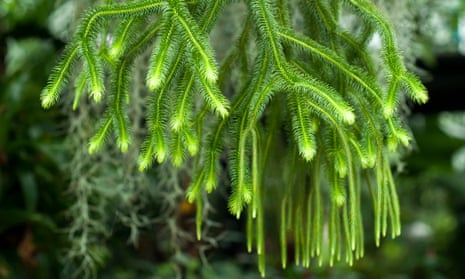With the huge surge of new tropical plant introductions flooding into the trade right now, it is probably the most exciting time in a century to be a houseplant collector. I wonder if this is what it felt like to be a head gardener of a grand estate in Victorian England, when plant hunters were sending back a flurry of new introductions from all over the globe that had never been seen in Britain before. During the first few years of the recent houseplant renaissance, many “new” plants were, in fact, just 1970s staples making a long-overdue comeback, but suddenly there seem to be dozens of truly “new” species, even entire genera, entering the UK market for the first time. There are dozens to pick from, but it’s hard to think of one that’s more weird and wonderful than the huperzia.
I first saw these amazing plants at a roadside plant stall high up in the mountains of rural Borneo in the early 2000s. Growing upside down straight out of the bottom of wire hanging baskets were Rapunzel-like cascades of what looked just like fluffy green pipe cleaners. Proper cartoon Martian stuff. One of the earliest forms of land plant, the huperzia has a wonderfully primitive growth pattern called bifurcation, where its tips literally split in two, giving its branches a forked “Y” shape. The interesting thing is that this isn’t just the case in the parts above ground as even the skinny, white roots are a fuzzy mass of forks.
Adapted to grow high in the canopies of rainforest trees, clinging to moss-covered branches, they are perfect candidates to grow in shady east- or west-facing windows, where they will handle intermittent watering and forgetful fertilising. I had thought they would insist on the sky-high humidity only possible in terrarium culture, but I am slowly discovering nothing could be further from the truth. They’ll quite happily live in everyday apartment conditions in pots of pure sphagnum moss, and only need water once a fortnight. In fact, much like stag horn ferns, they positively prefer to dry out between waterings.
My favourite of them all is the Huperzia squarrosa, which has irresistibly tactile locks of emerald green, Muppety fuzz. A new cultivar called ‘Patto’ has stouter, densely leaved branches that makes it look even more mammalian. H nummulariifolia trades hairiness for shiny chains of little, deep green discs, like a botanical beaded curtain. H goebelii is different again, with spiky showers of silver-blue leaves, like an exotic weeping conifer. I can’t tell you how hard it was to pick just three given the dozen or so more amazing species now kicking around.
Being relatively newly introduced, huperzias can require some online sleuthing to them track down at a handful of indie British nurseries that sell them at auction sites, but it’s worth it. They are true wonders of the botanical world that previous generations of indoor gardeners could only dream of growing.
Follow James on Twitter @Botanygeek
